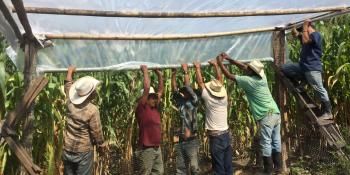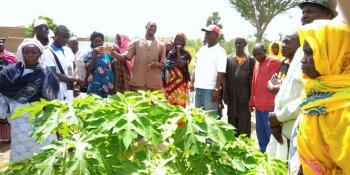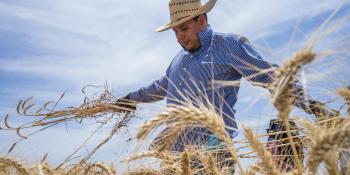Ninigui: A war against… erosion and desertification. - Part II: Adama’s crops in the desert

“My grandparents grew crops without any fertilizer, and had no problems. But with the 20 hectares I inherited, the yield was not enough to even feed my own family”, sighs Ganame Adama. “The forest was gone; the fertile soil was taken away by the waters gushing over the land during the rainy season. A hard crust was everything we were left with. We had to find ways to use that water.”
The people from Ninigui, in Burkina Faso’s north, looked for advise from other farmers who lived through similar challenges. They learned how to build small dams, called ‘diguettes’, ‘digues’ or ‘digues filtrantes’ to break the water flow and block the fertile ground from running off: Using a simple long tube, filled with water, they mark ‘contour lines’ with sticks: areas on their flat plots which are at an equal height. Then they stack rocks, only half a foot high, following those contour lines.

“These dams break the flow of the water as it gushes off the plains. While the rain water slowly seeps through one dam, the soil carried by the water, sinks to the bottom, forming strips of fertile land. The water leaking through one dam is stopped again by the dam on the next contour line, about twenty meters further down the slow slope. And again on the next, and again. Each time, a fertile strip of land forms between the lined-up rocks”, explains Adama.
It is only now I notice all stones stacked, snaking through the landscape. It is a remarkable sight, actually, as you can see the vegetation pushing through on the treated plots, in sharp contrast with the barren landscape of the areas without any “digues”. It reminds me of similar techniques used to construct terraces in the mountains of South-East Asia, but now applied on almost flat plains. The effect is the same: the soil heaps up between the stone dams, creating strips of fertile land.
 Adama continues: “Between the contour lines, between the digues, we sow in zai’s: staggered holes, a few inches deep. We sow in the zai’s, and cover them with compost. As the water slowly runs through the ‘digues’, it fills the zai’s. Once the first zai’s are full, the water spills over onto the next, and the next. In each zai, the water, combined with the compost, slowly seeps into the ground. When the seed shoots and starts to grow, we can do for several weeks between rains. The crop continues to grow, as the zai is almost like a small island of fertile, wet soil.”
Adama continues: “Between the contour lines, between the digues, we sow in zai’s: staggered holes, a few inches deep. We sow in the zai’s, and cover them with compost. As the water slowly runs through the ‘digues’, it fills the zai’s. Once the first zai’s are full, the water spills over onto the next, and the next. In each zai, the water, combined with the compost, slowly seeps into the ground. When the seed shoots and starts to grow, we can do for several weeks between rains. The crop continues to grow, as the zai is almost like a small island of fertile, wet soil.”
As the rains have become more erratic, starting later in the season and ending earlier, Adama uses the slow growing millet seeds from his grandfathers and combines it with new varieties which grow much faster. “This way, no matter if I have a long rainy season, or a short one, at least one variety always does well. It’s like I am spreading my risk.”
The result is simply amazing. Several years ago, Adama could not feed his family with 20 hectares of land, but with just 3 hectares and new simple techniques, the harvest fills his grain store. “This year, the crop is that good, I will have to build a second grain store”, he smiles, “I not only feed my family, but can also sell off what I have left over.”
NAAM, the farmers’ union he chairs, is not short of new initiatives. They also built dams in the ‘ravines’, the deep trenches cut by the water on the steeper slopes. “There, we can not just stack stones as we do on the flats as they will be washed away. We need to reinforce them using a simple technique of stacking huge nets of weaved metal filled with boulders.”
As the dams break the flow of the water gushing down the gullies, and let it filter through slowly, the soil forms a fertile terrace, used as a plot to grow crops.

“The digues are fine, but to fight against the longer term problem of erosion, there is only one solution”, prophesizes Adama: “Trees! “. His fertile plots are dotted with low scrubby bushes. “Gum trees, we planted some years back. And we continue to plant more. You will see, come back ten years from now, this will be a forest again. The trees will not only stop the soil from running off, but we can also use them for timber and charcoal, as long as we continue to plant more of them. We can not chop them without replanting, or the same problem will start all over again.”
As he walks through the young trees, hardly taller than him, he touches the leaves with tenderness, as if – it occurs to me – he is touching his future.
The way ahead for researchers and smallholder farmers facing current and coming challenges posed by climate change lies in learning from each other while sharing knowledge and experiences.
Photos in this article by Peter Casier.


